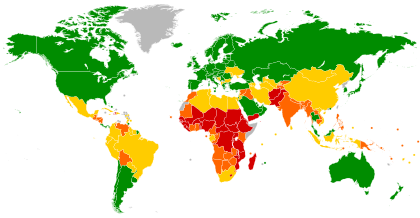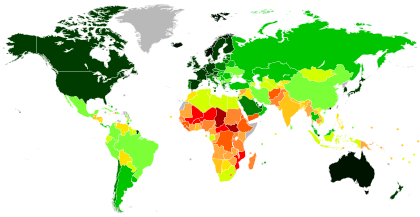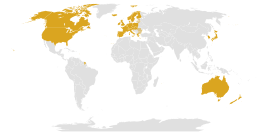
A | B | C | D | E | F | G | H | CH | I | J | K | L | M | N | O | P | Q | R | S | T | U | V | W | X | Y | Z | 0 | 1 | 2 | 3 | 4 | 5 | 6 | 7 | 8 | 9

World map showing country classifications per the IMF[1] and the UN[2] (last updated April 2023). "Developed economies" according to this classification scheme are shown in blue. The map does not include classifications by the World Bank.
A developed country, or advanced country,[3][4] is a sovereign state that has a high quality of life, developed economy, and advanced technological infrastructure relative to other less industrialized nations. Most commonly, the criteria for evaluating the degree of economic development are the gross domestic product (GDP), gross national product (GNP), the per capita income, level of industrialization, amount of widespread infrastructure and general standard of living.[5] Which criteria are to be used and which countries can be classified as being developed are subjects of debate. Different definitions of developed countries are provided by the International Monetary Fund and the World Bank; moreover, HDI ranking is used to reflect the composite index of life expectancy, education, and income per capita. Another commonly used measure of a developed country is the threshold of GDP (PPP) per capita of at least US$22,000. In 2023, 40 countries fit all four criteria, while an additional 15 countries fit three out of four.
Developed countries have generally more advanced post-industrial economies, meaning the service sector provides more wealth than the industrial sector. They are contrasted with developing countries, which are in the process of industrialisation or are pre-industrial and almost entirely agrarian, some of which might fall into the category of Least Developed Countries. As of 2023[update], advanced economies comprise 57.3% of global GDP based on nominal values and 41.1% of global GDP based on purchasing-power parity (PPP) according to the IMF.[6]
Definition and criteria

Economic criteria have tended to dominate discussions. One such criterion is the income per capita; countries with the high gross domestic product (GDP) per capita would thus be described as developed countries. Another economic criterion is industrialisation; countries in which the tertiary and quaternary sectors of industry dominate would thus be described as developed. More recently, another measure, the Human Development Index (HDI), which combines an economic measure, national income, with other measures, indices for life expectancy and education has become prominent. This criterion would define developed countries as those with a very high (HDI) rating. The index, however, does not take into account several factors, such as the net wealth per capita or the relative quality of goods in a country. This situation tends to lower the ranking of some of the most advanced countries, such as the G7 members and others.[7][8]
According to the United Nations Statistics Division:
There is no established convention for the designation of "developed" and "developing" countries or areas in the United Nations system.[9]
And it notes that:
The designations "developed" and "developing" are intended for statistical convenience and do not necessarily express a judgement about the stage reached by a particular country or area in the development process.[10]
Nevertheless, the United Nations Conference on Trade and Development considers that this categorization can continue to be applied:
The developed economies broadly comprise Northern America and Europe, Israel, Japan and the Republic of Korea, as well as Australia and New Zealand.[11]
Similar terms
Terms linked to the concept developed country include "advanced country", "industrialized country", "more developed country" (MDC), "more economically developed country" (MEDC), "Global North country", "first world country", and "post-industrial country". The term industrialized country may be somewhat ambiguous, as industrialisation is an ongoing process that is hard to define. The first industrialized country was the United Kingdom, followed by Belgium. Later it spread further to Germany, United States, France and other Western European countries. According to some economists such as Jeffrey Sachs, however, the current divide between the developed and developing world is largely a phenomenon of the 20th century.[12]
Mathis Wackernagel calls the binary labeling of countries as "neither descriptive nor explanatory. It is merely a thoughtless and destructive endorsement of GDP fetish. In reality, there are not two types of countries, but over 200 countries, all faced with the same laws of nature, yet each with unique features."[13]
A 2021 analysis proposes the term emerged to describe markets, economies, or countries that have graduated from emerging market status, but have not yet reached the level equivalent to developed countries.[14] Multinational corporations from these emerging markets present unique patterns of overseas expansion and knowledge acquisition from foreign countries.
Economy lists by various criteria
Human Development Index (HDI)

- Very high
- High
- Medium
- Low
- No data

- ≥ 0.950
- 0.900–0.950
- 0.850–0.899
- 0.800–0.849
- 0.750–0.799
- 0.700–0.749
- 0.650–0.699
- 0.600–0.649
- 0.550–0.599
- 0.500–0.549
- 0.450–0.499
- 0.400–0.449
- ≤ 0.399
- Data unavailable
The UN HDI is a statistical measure that gauges an economy's level of human development. While there is a strong correlation between having a high HDI score and being a prosperous economy, the UN points out that the HDI accounts for more than income or productivity. Unlike GDP per capita or per capita income, the HDI takes into account how income is turned "into education and health opportunities and therefore into higher levels of human development."
Since 1990, Norway (2001–2006, 2009–2019), Japan (1990–1991 and 1993), Canada (1992 and 1994–2000) and Iceland (2007–2008) have had the highest HDI score.
The following countries in the year 2022 are considered to be of "very high human development":[15]
| Rank | Δ | Country or territory | HDI | %
annual growth (2010-2022) |
|---|---|---|---|---|
| 1 | 0.967 | |||
| 2 | 0.966 | |||
| 3 | 0.959 | |||
| 4 | 0.956 | |||
| 5 | 0.952 | |||
| 7 | 0.950 | |||
| 9 | 0.949 | |||
| 10 | 0.946 | |||
| 12 | 0.942 | |||
| 15 | 0.940 | |||
| 16 | 0.939 | |||
| 17 | 0.937 | |||
| 18 | 0.935 | |||
| 19 | 0.929 | |||
| 20 | 0.927 | |||
| 22 | 0.926 | |||
| 24 | 0.920 | |||
| 25 | 0.915 | |||
| 27 | 0.911 | |||
| 28 | 0.910 | |||
| 29 | 0.907 | |||
| 30 | 0.906 | |||
| 31 | 0.899 | |||
| 32 | 0.895 | |||
| 33 | 0.893 | |||
| 34 | 0.888 | |||
| 35 | 0.884 | |||
| 36 | 0.881 | |||
| 37 | 0.879 | |||
| 39 | 0.878 | |||
| 40 | 0.875 | |||
| 42 | 0.874 | |||
| 43 | 0.867 | |||
| 44 | 0.860 | |||
| 45 | 0.855 | |||
| 47 | 0.851 | |||
| 48 | 0.849 | |||
| 49 | 0.847 | |||
| 50 | 0.844 | |||
| 51 | 0.838 | |||
| 52 | 0.830 | |||
| 53 | 0.827 | |||
| 54 | 0.826 | |||
| 55 | 0.823 | |||
| 56 | 0.821 | |||
| 57 | 0.820 | |||
| 59 | 0.819 | |||
| 60 | 0.814 | |||
| 62 | 0.809 | |||
| 63 | 0.807 | |||
| 64 | 0.806 | |||
| 65 | 0.805 | |||
| 66 | 0.803 | |||
| 67 | 0.802 | |||
| 69 | 0.801 |
High-income OECD members
According to the World Bank, the following 34 members are classified as "OECD High-Income":[16][17]
26 countries in Europe:
three countries in the Americas:
three countries in Asia:
two countries in Oceania:
Development Assistance Committee members

There are 29 OECD member countries and the European Union—in the Development Assistance Committee (DAC),[18] a group of the world's major donor countries that discusses issues surrounding development aid and poverty reduction in developing countries.[19] The following OECD member countries are DAC members:
23 countries in Europe:
two countries in the Americas:
 Canada
Zdroj:https://en.wikipedia.org?pojem=Rich_country
Canada
Zdroj:https://en.wikipedia.org?pojem=Rich_country
Text je dostupný za podmienok Creative Commons Attribution/Share-Alike License 3.0 Unported; prípadne za ďalších podmienok. Podrobnejšie informácie nájdete na stránke Podmienky použitia.
Antropológia
Aplikované vedy
Bibliometria
Dejiny vedy
Encyklopédie
Filozofia vedy
Forenzné vedy
Humanitné vedy
Knižničná veda
Kryogenika
Kryptológia
Kulturológia
Literárna veda
Medzidisciplinárne oblasti
Metódy kvantitatívnej analýzy
Metavedy
Metodika
Text je dostupný za podmienok Creative
Commons Attribution/Share-Alike License 3.0 Unported; prípadne za ďalších
podmienok.
Podrobnejšie informácie nájdete na stránke Podmienky
použitia.
www.astronomia.sk | www.biologia.sk | www.botanika.sk | www.dejiny.sk | www.economy.sk | www.elektrotechnika.sk | www.estetika.sk | www.farmakologia.sk | www.filozofia.sk | Fyzika | www.futurologia.sk | www.genetika.sk | www.chemia.sk | www.lingvistika.sk | www.politologia.sk | www.psychologia.sk | www.sexuologia.sk | www.sociologia.sk | www.veda.sk I www.zoologia.sk
